We have already covered our numerous assorted driftwoods and stones in our hardscape article. While you can buy individual pieces of driftwood as single items in our web shop, decorative rocks are sold by the kilogram. With this article we'd like to help you choose the right kind of stones and the weight of the appropriate amount for your planted tank.
Weight and volume
The joke "What's heavier - 1 kg of feathers or 1 kg of lead?” is also true for the various decorative stone types available for aquascaping. At the same weight, different stones may vary drastically in size. Porous stones such as most of the Lava types offer more volume than denser stones such as Frodo Stones or Yangtse Rocks. This becomes pretty clear when we take a closer look at Lava which has easily perceptible, large-pored air pockets and thus a low density. Island Lava is especially remarkable; in some cases the lava stones didn't even sink but floated on the surface for a short while due to their low density.
Here you can see all the types of stones available at Aquasabi in comparison. All of them weigh the same (1 kg), but they differs significantly in size. From top left to bottom right: Black Lava, Loa Rocks, Galapagos Rock, Tsingy Rock, Ohko Dragon Stone , Mini Landscape Seiryu, Black Pagoda, Black Rocks, Elephant Skin Rocks, Yangtse Rock, and Frodo Stone.
One kg of stones?
In our shop you can buy various types of stone starting at a minimum amount of one kilogram. Many customers buy only this amount, hoping that it is sufficient for a small nano-tank, but basically, one kilogram isn't nearly enough unless you decide to use a very light grade like lava rock.
When you are about to delve deeper into the world of aquascaping, it is good advice to always buy a bit more hardscaping material than you initially intended. Not all of it is going to be used, but you’ll have a better stash to pick from and also a selection of spares in case you want to complement or replace your hardscape at a later time. The golden rule: Don't save at the wrong end. Imagine a painter: He doesn’t calculate the exact amount of paint he’s going to need for just THAT one painting he’s about to work on, but instead has a vast supply of various paints at hand so he can spread his wings and draw upon a full scope of artistic aptitude and possibilities. An aquascaper should look at his stone materials in the same way
To be able to scape at the highest level of detail, you should have access to numerous shapes and sizes of preferably the same sort of stone – from large "main stones“ to tiny shards. Please keep in mind that almost all our types of stones have a certain minimum size we cannot go below for delivery. If you need shards and smaller fragments, you should make your own. Depending on the type of stone, they are easy to make: Just use a hammer and chisel, and do so liberally. Please note: For safety reasons, always cover the stone you want to crush with a piece of cloth so the shards won't hurt anybody.
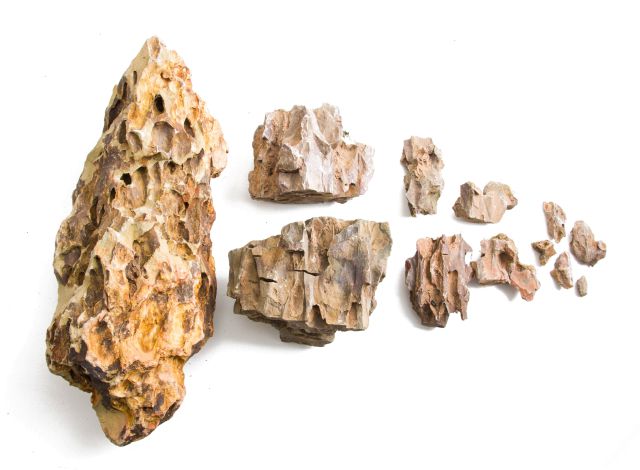
Ohko Dragon Stone in various sizes. This type of stone is very easy to crush.
Especially if you are planning a planted tank with lots of fast-growing plants, make sure you use massive rocks for your hardscape from the beginning. Keep in mind that at least half of the hardscape is going to vanish behind the plants at a later time and that the initially massive impression of your hardscape will be diminished significantly.
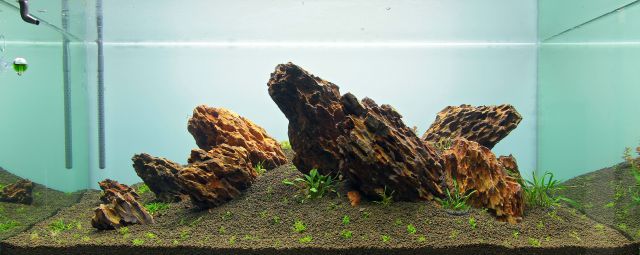
Massive hardscape shortly after set-up.
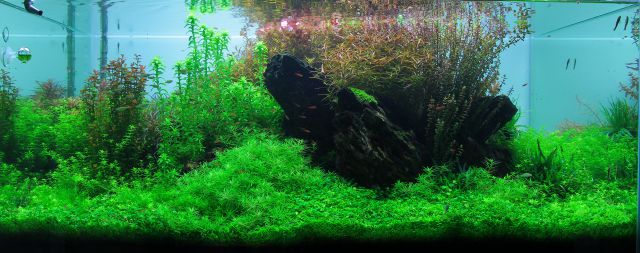
The same aquascape a couple of months later with the plants basically dominating the view.
Rule of thumb
Calculating the amount of stones in kilograms you are going to need for your tank is a two-step process. First, use the following rule of thumb as a guideline:
Gross volume of your tank in liters divided by six = the approximate amount of decorative stones in kilograms.
For your convenience you'll find a rough overview of the most common tank sizes in the following:
- 20 l aquarium or Mini M: 3,5 kg
- 30 l cube: 5 kg
- 54 l standard aquarium: 9 kg
- 182 l ADA 90-P: 30 kg
- 250 l aquarium with 1 m front length: 42 kg
Now on to step 2: The approximate weight resulting from above formula can be adapted to the type of stone you have chosen a bit more precisely. To do so, we need to multiply the result of the rule-of-thumb-formula with a factor specific to each of the stone types listed below. This factor is the so-called bulk density, also known as bulk weight. The lighter the stones, the smaller the factor! You'll need considerably less of light types such as lava and more of heavy stones.
One example: We'll apply the rule of thumb for our standard 54 liter tank: 54/6 = 9 kg of stones. We have chosen Frodo Stones, and therefore we need to multiply the result with 1.2. This gives us a necessary amount of nearly 11 kilograms of Frodo Stones. Should you decide against Frodo since you want to use the lighter Loa Rocks instead, multiply amount of 9 kilograms with 0.8 - resulting in a mere 7.2 kilograms. A very noticeable difference!
An overview of the stone types sorted by bulk weight
Factor: 0,7
-
Black Lava, a dark, porous stone. Neutral in water. Ideal for planting with epiphytes and aquatic mosses. Works very well in combination with driftwood. Easy to crush with a hammer and chisel due to its low density.
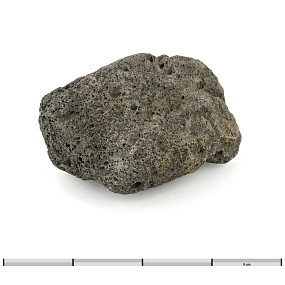
Factor: 0,8
-
Loa Rocks, a beautifully rugged, dark lava rock. Neutral in water. The rough surface lends itself to planting with epiphytes and mosses. The unique grain makes this stone attractive for recreating scenic landscapes and for the creation of Iwagumi layouts.
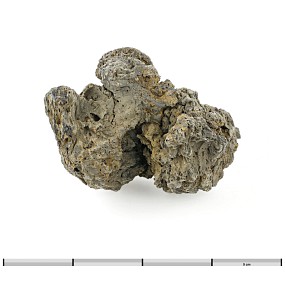
Factor: 0,9
-
Galapagos Rock, a porous, dark stone with some brown color accents. Like our other lava varieties, it is neutral in water and can be planted beautifully with epiphytic plants and mosses. Can be combined well with aquarium driftwood, and due to its color scheme it’s also quite suitable for pure stone designs like Iwagumi.
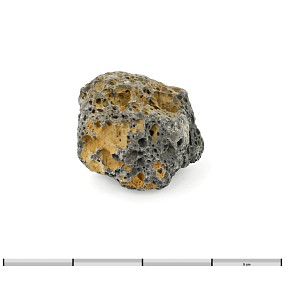
-
Tsingy Rock, a light grey, very nicely structured stone, sometimes unconventionally shaped. As a result, these stones are true eyecatchers, and you can create very imaginative layouts with them. They may harden the water slightly.
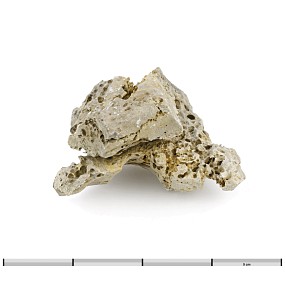
Factor: 1
-
Dragon Stone Ohko, a brown to reddish stone with an intense, pitted grain. Its deep fissures are perfect for planting with mosses and epiphytes. Neutral in water. Can be crushed into fragments quite easily. Before using it in the aquarium, remove all clay residues by thoroughly rinsing the rocks. Very suitable for Iwagumi layouts.
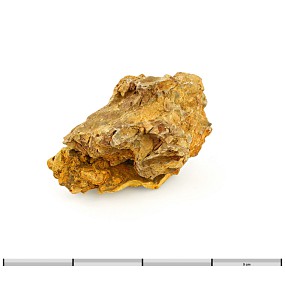
-
Mini landscape Seiryu, a grey stone, beautifully rugged, sometimes with white veins. Hardens the water slightly. Reminiscent of small mountain ranges and therefore perfect for recreating landscapes under water. Quite a compact stone but workable with hammer and chisel.
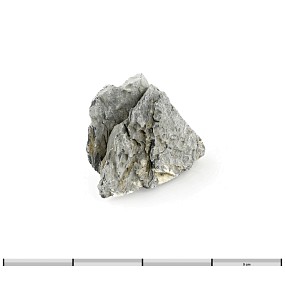
-
Black Pagoda, a dark grey stone with brown veins, sometimes layered and therefore very nice for canyons or canyon landscapes under water. Hardens the water slightly.
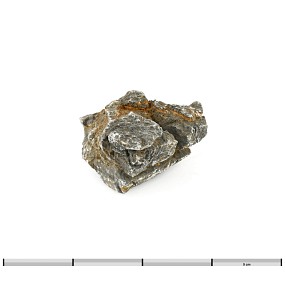
-
Black Rock, a deep black, broken stone, which may slightly harden the water. The dark color is really unique and very intense. A great contrast to green and red plants.
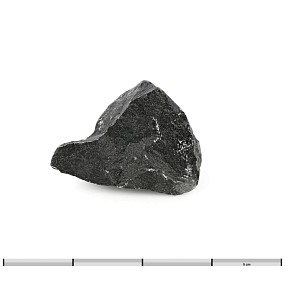
Factor: 1,1
-
Elephant Skin Rock, a lighter, roundish stone, nicely rugged. Hardens the water slightly. The grain is reminiscent of small mountain ranges. This type of stone is very well suited as a supporting stone in combination with driftwood. Higher density, therefore less easy to crush into smaller fragments.
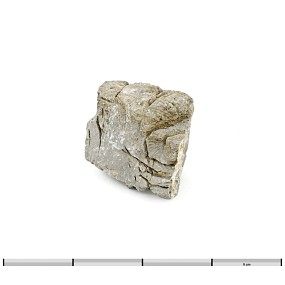
Factor: 1,2
-
Yangtse Rock, a roundish stone with white, yellow, brown or gray hues. Ideal for emulating riverbeds or streams. The stones are neutral in water and have a minimum size of 10 cm, which makes them great for larger aquaria. Due to its higher density, this stone is not easily crushed.
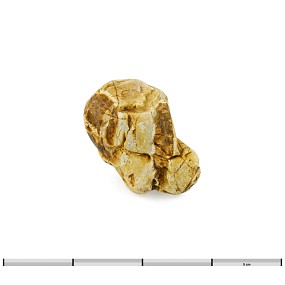
-
Frodo Stone, a grey-brown stone with deep furrows. Ideal for creating Iwagumi layouts, but also great in combination with driftwood. Hardens the water slightly. Very heavy, compact stone, difficult to break into smaller fragments.
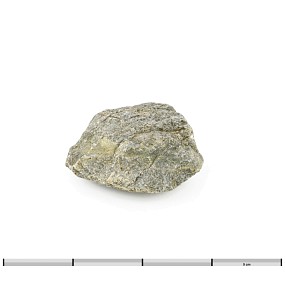
Note: Of course, in addition to this list you can also find the ADA brand decorative stones in our web shop, such as Kei Stones, Koke Stones or Sansui Stones. All types of ADA stones are sold in packages prefabricated by ADA and are not available as loose goods.